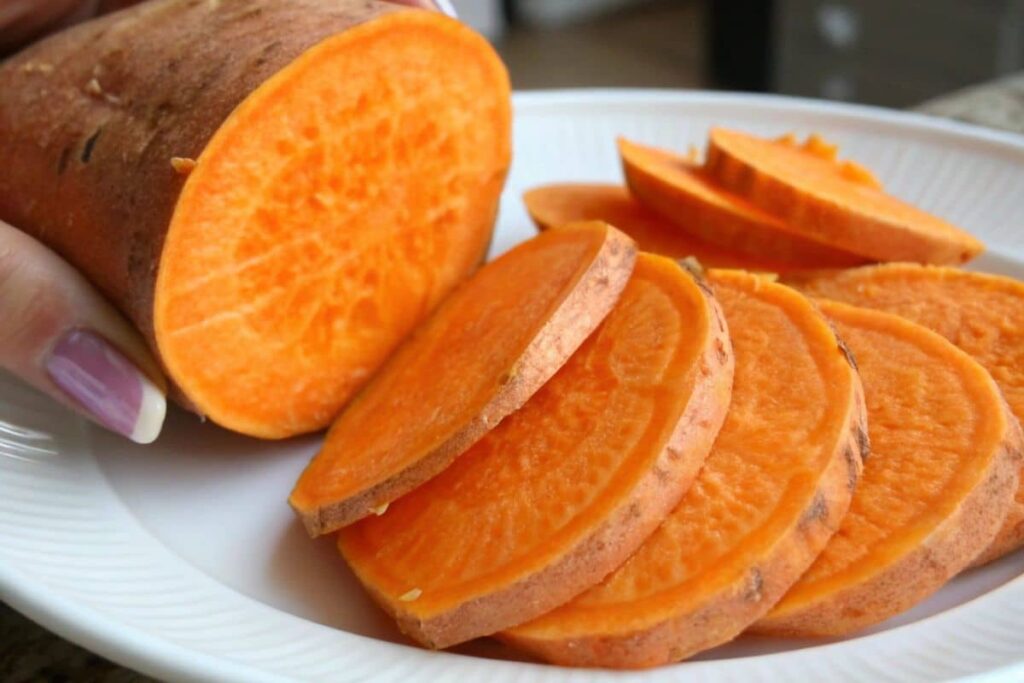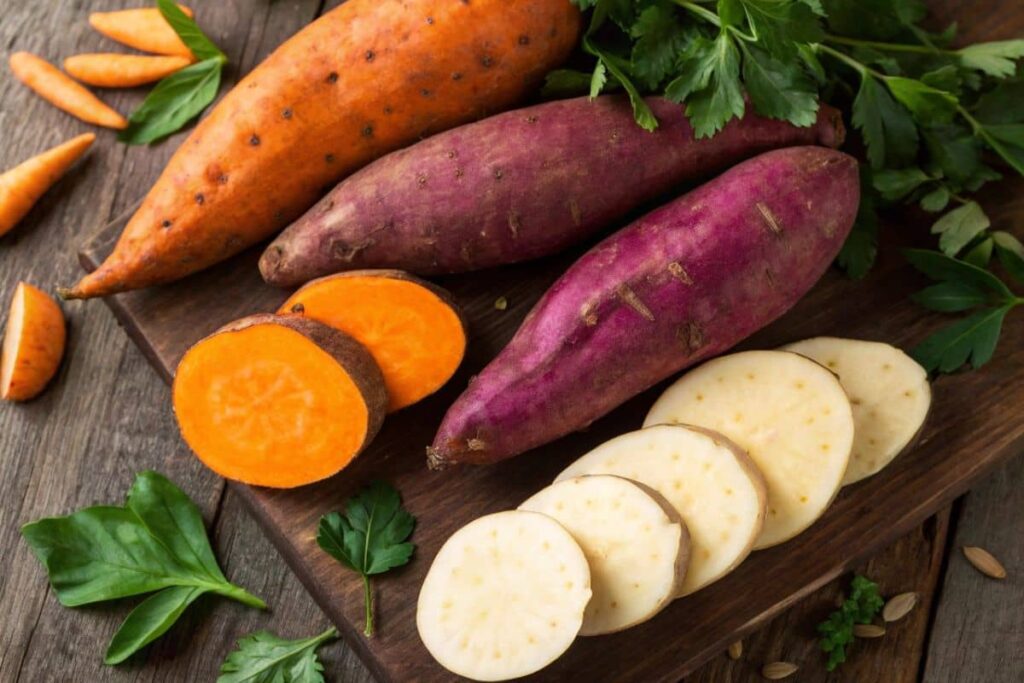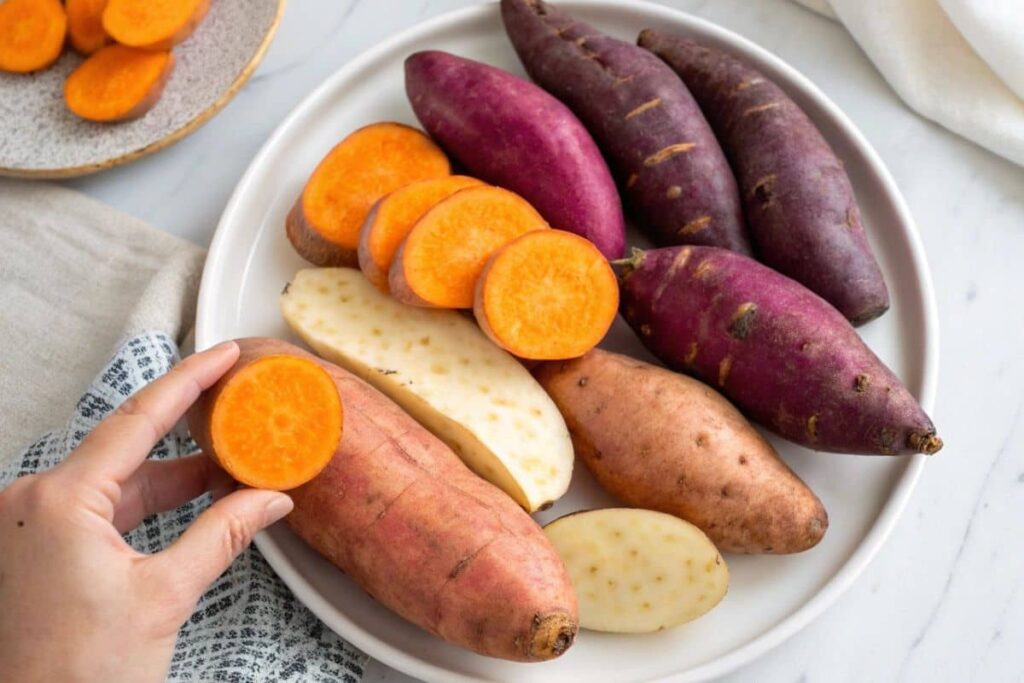Is Sweet Potato A Fruit Or Vegetable? It’s a question that has left many food enthusiasts scratching their heads. At first glance, the answer might seem obvious, but when you dig deeper, it’s far more fascinating than you’d expect. By the time you finish this article, you’ll not only know the answer but also gain some fun facts to impress your friends at your next dinner table chat. Ready to uncover the truth? Let’s dive in!
Table of Contents

The Confusion Between Fruits and Vegetables
Have you ever sat at the dinner table, munching on a delicious sweet potato dish, and wondered, “Is sweet potato a fruit or vegetable?” You’re not alone! Most people assume they know the answer, but there’s a surprising twist to it. To really figure this out, we need to understand what separates fruits from vegetables in the first place.
Spoiler alert: It’s not as simple as taste! Some foods that we call vegetables are actually fruits, and vice versa. But where does the sweet potato fall?
What Defines a Fruit vs. a Vegetable?
To settle the sweet potato debate, let’s first look at what makes a fruit a fruit and a vegetable a vegetable. Believe it or not, it’s not about sweetness—though that’s what many people think! So, is sweet potato a fruit or vegetable? The answer lies in its botanical classification.
The Botanical Definition of Fruits
In botanical terms, a fruit is the mature ovary of a flowering plant, usually containing seeds. Simply put, if it grows from a flower and has seeds inside (like apples, tomatoes, or cucumbers), it’s considered a fruit.
But since sweet potatoes don’t contain seeds, does that mean they’re vegetables? Or is there more to the story? Keep reading to find out!
“If it’s got seeds and comes from a flower, it’s a fruit—no matter how it tastes!”
The Culinary Definition of Vegetables
Here’s where things get tricky. In the kitchen, we classify fruits and vegetables based on taste and usage. Vegetables are typically savory and form the backbone of our main meals—think carrots, spinach, or potatoes. Sweet potatoes, with their earthy flavor, often fall into this category. But do they belong there scientifically?
Where Does the Sweet Potato Fit In?
So, is sweet potato a fruit or vegetable? The answer depends on how you look at it.
The Botanical Perspective of Sweet Potatoes
From a botanical point of view, sweet potatoes are vegetables. They’re the tuberous roots of the plant Ipomoea batatas, which means they grow underground and don’t have seeds inside. This automatically disqualifies them from being fruits.
The Culinary Classification of Sweet Potatoes
In the culinary world, sweet potatoes are unquestionably vegetables. Their rich, starchy texture makes them perfect for savory dishes, though their natural sweetness has earned them a place in desserts like sweet potato pie. Basically, sweet potatoes are the best of both worlds!
Why Do People Mistake Sweet Potatoes for Fruits?
If sweet potatoes are scientifically and culinarily vegetables, why do so many people wonder if they’re fruits? Let’s explore the reasons behind this common misconception.
The Role of Sweetness in Classification
Here’s the thing: when we taste something sweet, our brains tend to associate it with fruits. Sweet potatoes, with their sugar content and dessert-worthy flavor, can confuse even the sharpest foodies. But sweetness isn’t the defining factor!
Common Misconceptions and Myths
One myth that fuels this confusion is that anything naturally sweet must be a fruit. This logic lumps sweet potatoes in with mangoes and strawberries, which is totally incorrect. Another misconception? People think the word “sweet” in sweet potato implies fruit status. Not true!
The History of Sweet Potatoes: Rooted in Tradition
Sweet potatoes aren’t just a modern-day favorite. They have a rich history that spans continents and cultures. Learning about their roots (pun intended!) can help us appreciate them even more.
Origins and Global Cultivation
Sweet potatoes originated in Central and South America, where indigenous people cultivated them thousands of years ago. Today, they’re grown worldwide, with major producers like the United States, China, and Japan. Fun fact: Sweet potatoes are different from yams, even though they’re often confused for each other!
Sweet Potatoes in Cultural and Culinary Practices
Sweet potatoes have been a staple in many cuisines, from African stews to Japanese tempura. They’ve also played an important role in celebrations like Thanksgiving, where sweet potato casseroles take center stage.
Nutritional Profile: The Best of Both Worlds?
Sweet potatoes aren’t just delicious—they’re also packed with nutrients. Whether you’re team fruit or team vegetable, there’s no denying their health benefits.
| Nutrient | Amount Per 100g |
|---|---|
| Calories | 86 kcal |
| Carbohydrates | 20.1 g |
| Dietary Fiber | 3 g |
| Vitamin A | 283% of RDA |
| Vitamin C | 4 mg |
| Potassium | 337 mg |
| Protein | 1.6 g |
Sweet potatoes are rich in beta-carotene (which our bodies convert to Vitamin A), making them great for your eyesight and immune system. Plus, they’re high in fiber, which is excellent for digestion.
Sweet Potato Varieties: Are They All the Same?
Sweet potatoes come in more varieties than you might realize, and not all of them look or taste the same. Each type has unique characteristics that make it special.

Orange, Purple, and White Sweet Potatoes
- Orange Sweet Potatoes: These are the most common and contain high levels of beta-carotene, giving them their vibrant orange color. They’re sweet and creamy, perfect for casseroles or roasting.
- Purple Sweet Potatoes: Known for their striking color and nutty flavor, these are rich in antioxidants like anthocyanins (also found in blueberries!).
- White Sweet Potatoes: Milder in flavor and less sweet, these are starchier and often used in savory dishes.
Which Varieties Are More “Fruit-like”?
Interestingly, the sweeter varieties like orange and purple sweet potatoes might seem more “fruit-like” due to their sugary flavor. However, their classification as root vegetables remains unchanged. Think of them as vegetables with fruity personalities! 🍇
The Sweet Potato Debate: Problems and Questions Answered
When it comes to sweet potatoes, people have plenty of questions. Let’s tackle some of the most common ones.
Commonly Asked Questions: Is It a Fruit or Vegetable?
When it comes to sweet potatoes, people have a lot of questions—and some of them might surprise you. Let’s break down the most common ones in detail.
“Why isn’t it a fruit if it’s sweet?”
Ah, the sweetness! It’s easy to see why people get confused. Sweetness is often associated with fruits like mangoes, strawberries, and oranges. But here’s the kicker: sweetness doesn’t determine whether something is a fruit or a vegetable.
From a botanical perspective, what makes a fruit a fruit is its origin—it must develop from the flower of a plant and contain seeds. Think of apples, tomatoes, or cucumbers. These all have seeds and grow directly from a flower.
Sweet potatoes, however, are tubers, which means they are a part of the plant’s root system. They grow underground and do not originate from a flower, which automatically disqualifies them as fruits, no matter how sweet they taste.
Fun fact: Some vegetables, like carrots and beets, can also have a hint of sweetness. Does that make them fruits? Nope!
Key takeaway: Sweetness doesn’t make something a fruit—seeds and flowers do!
“What makes it different from regular potatoes?”
Many people think sweet potatoes and regular potatoes are closely related, but they’re actually from entirely different plant families. Let’s break it down:
- Family Differences:
- Sweet potatoes belong to the Convolvulaceae family, which includes morning glories.
- Regular potatoes are part of the Solanaceae family, also known as the nightshade family.
- Nutritional Differences:
Sweet potatoes are powerhouses of nutrition! They’re packed with beta-carotene (the precursor to Vitamin A), which gives them their signature orange hue. Regular potatoes, while still nutritious, don’t have the same levels of vitamins. - Taste and Texture:
Sweet potatoes live up to their name with a naturally sweet and creamy flavor, making them a favorite for both desserts and savory dishes. Regular potatoes, on the other hand, are more neutral and starchy, ideal for mashing, frying, or baking. - Cultural Use:
Sweet potatoes are often used in festive and sweet dishes (like pies or casseroles), whereas regular potatoes are staples for sides like fries, mashed potatoes, or stews.
Did you know? Sweet potatoes are sometimes mistaken for yams, but they’re not the same thing either. Yams are starchy tubers from a different plant family and are much drier in texture.
Scientific and Culinary Community Opinions
If you’re still debating the true identity of sweet potatoes, let’s turn to the experts for clarity. Spoiler alert: they all agree on the answer.
Botanical Experts’ View
Botanists classify sweet potatoes as vegetables because they are root tubers that grow underground. Unlike fruits, they don’t contain seeds in their edible parts or develop directly from a flower—two essential traits that distinguish fruits from vegetables
Culinary Experts’ View
Chefs worldwide embrace sweet potatoes for their versatility and typically categorize them as vegetables. Why? Because they’re commonly prepared in savory ways—roasted, mashed, or added to hearty dishes. Even in desserts like sweet potato pie, they’re still treated as vegetables.
But here’s a fun idea: Does their classification really matter? In the end, sweet potatoes are all about their deliciousness and nutritional value. Their ability to shine in everything from savory stews to indulgent desserts makes labels seem unnecessary.
Would You Love Them Any Less If They Were Fruits?
Here’s the big question: If sweet potatoes were reclassified as fruits, would it really matter? Probably not! What truly counts is their flavor, nutrition, and the joy they bring to your meals. Whether you see them as tubers, vegetables, or honorary fruits, sweet potatoes are here to stay—and that’s what makes them so special.

How Sweet Potatoes Are Used in Cooking
Sweet potatoes are cherished for their incredible versatility. They seamlessly transition between savory and sweet dishes, earning their place as a staple in kitchens around the globe.
Sweet and Savory Recipes
- Savory: Sweet potato fries, mashed sweet potatoes, or even a hearty sweet potato and black bean chili. Yum!
- Sweet: Sweet potato pie, muffins, or a caramelized sweet potato dessert. Their natural sugars shine in these recipes.
Sweet Potatoes vs. Other Fruits and Vegetables in Recipes
Have you ever noticed how sweet potatoes blur the line between fruits and vegetables? They’re a go-to ingredient for desserts, acting like fruits with their natural sweetness, yet their starchy texture makes them ideal substitutes for vegetables like squash or pumpkin.
Sweet Potatoes and Sustainability
In a world where sustainability matters more than ever, sweet potatoes stand out as a delicious and eco-friendly choice.
Environmental Impact of Growing Sweet Potatoes
Sweet potatoes are robust crops that thrive with minimal water and resources, making them an environmentally friendly option for both farmers and consumers..
Versatility in Diverse Climates
Sweet potatoes flourish in diverse climates, from tropical to temperate regions, making them a globally cultivated crop. Their resilience also makes them a dependable food source in areas facing challenging weather conditions.
The Future of Sweet Potatoes: Culinary and Scientific Potential
What’s next for this incredible vegetable? Plenty! From creative culinary innovations to advancements in agriculture, sweet potatoes are poised to play an even bigger role in our kitchens and fields.
Exploring Sweet Potato’s Role in Hybrid Cuisine
Picture fusion dishes like sweet potato sushi rolls or sweet potato tacos—innovative twists that bring a fresh, flavorful spin to classic recipes!
Advances in Agricultural Research on Sweet Potatoes
Researchers are actively developing new sweet potato varieties that are both more nutritious and drought-resistant, aiming to address food insecurity in regions most affected by climate challenges.
Final Thoughts
Sweet potatoes are a unique food that sits at the intersection of fruits and vegetables. Packed with nutrition and culinary versatility, they truly stand out as a natural treasure. Whether mashed, roasted, or baked into a pie, sweet potatoes add vibrant flavor, rich color, and wholesome goodness to any meal.
If you’ve enjoyed learning about sweet potatoes, why stop here? Did you know that sweet potatoes can be eaten raw? Find out the surprising details in Can You Eat Raw Sweet Potato. And if you’re curious about their health benefits, don’t miss our deep dive into Is Sweet Potato Anti-Inflammatory? to discover why they’re considered a superfood.
Looking for some colorful recipe inspiration? Check out our guide to Purple Sweet Potato Recipes for some stunning and delicious ideas. And if you love exploring unique produce, you’ll also enjoy learning about Persian Cucumber, another versatile and healthy ingredient.
In the end, sweet potatoes are as versatile as you make them—whether they take center stage in your meal or serve as the foundation for a comforting dessert. Celebrate their uniqueness and let them bring a touch of natural sweetness to your table!






